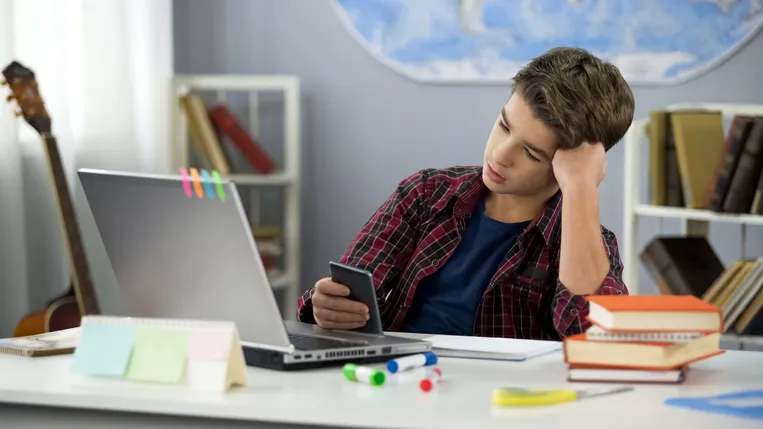
When we are trying to get work done, distractions are almost impossible to escape. Whether it's the sound of our smartphone pinging next to us, the loud chatter of conversation around us, or simply our own thoughts wandering to our weekend plans -- distractions are all around us. Adolescents (ages 10 to 19 years) are at an age where their brains are primed to learn and take in information rapidly, but their brains are also incredibly prone to distraction.
By understanding why adolescents are so easily distracted, we can better assist them in achieving focus and harnessing their brains' learning superpowers!
The Adolescent Brain
The distractibility of adolescents is far greater than that of adults and is said to be a result of the developing structure of their brains. During adolescence, certain areas of the brain mature at different rates than others.
The limbic system (the set of brain regions recognized to participate in emotion, memories, and arousal) matures early on in adolescents. Whereas, the prefrontal cortex (the control center of the brain -- responsible for planning, prioritizing, and impulse control) is one of the very last regions to mature fully. In the midst of distraction, the prefrontal cortex is largely responsible for achieving focus.
The adolescent brain also experiences a change in the levels of neurotransmitters, such as dopamine and serotonin, which explains their vulnerability to boredom and propensity for risk-taking behaviors. Nancy Pionnié-Dax, Head of Child Psychiatry at the Erasme Hospital in Paris, explains that, "This results in impulsiveness, a need for immediacy, a search for sensations and pleasures, without worrying about long-term effects."
When it comes to resisting distraction and focusing, the brains of adolescents are neurobiologically working against them.
Digital Distractions
These days, for adolescents and adults alike, digital technology, and more specifically smartphones, are the biggest distractions and obstacles to getting quality work done.
A 2013 study, aptly titled 'Facebook and texting made me do it', observed 279 middle school, high school, and college students during a 15-minute study session. Of the 15 minutes, only 9.65 minutes were spent actually studying. The study found that when students became distracted, their focus drifted to their smartphones more than 50% of the time. The same study framework was repeated in 2016 and it was found that every 5 minutes of the 15 minutes were spent distracted, and the time spent distracted by their smartphones increased from 50% to 75%.
It would then stand to reason that removing all digital distractions or turning them off would solve the problem, right? But that doesn't seem to be the case. Research has shown that for many chronic smartphone users, not having access to their devices can cause high levels of anxiety -- which in itself can be distracting. Other studies have found that just the physical presence of a smartphone has a negative impact on attention and cognitive performance.
In this sense, smartphones and other digital media can be both internally and externally distracting. If they aren't alerting us with notifications, our brains are often thinking about them or are aware of their presence. That's not to say that removing them from the study space or turning them off are not useful measures to reduce distraction. The anxiety and agitation produced by being separated from our smartphones do decline over time.
3 Tips to Help Your Child Focus
1. It All Starts with Sleep
Quality sleep is the greatest modulator of focus and attention and is incredibly important for adolescents. Several studies have shown that not only is sleep integral for learning and memory but, more importantly, for attention.
In a 2016 study, adolescents who slept for nine hours a night exhibited higher rates of sustained attention, working memory, and executive function than their sleep-deprived counterparts.
You can find our tips for improving your kids' quality of sleep here.
2. Take Breaks
Taking breaks in between periods of intense focus is highly beneficial to energy, brain replenishment, productivity, and the brain's ability to focus. Biologically speaking, our bodies and brains operate within 90-minute ultradian cycles which make up our day. The ultradian cycle is similar to an attention cycle.
After a period of focus, our brains often feel exhausted. It takes about 10-30 minutes following a period of focus for brains to deliberately de-focus. In this instance, it is useful to take a break and give yourself time to decompress and not focus on one thing.
Our ability to focus is dependent on what we do during our breaks in between focus sessions. Some studies have even found that periods of 'micro-rest' (breaks of 10 seconds during a task) are highly effective and result in improved learning and memory.
3. Experiment with Focus Music
Once the quality of sleep is addressed, and breaks are introduced into homework or study time, there are an array of tools to play around with to improve focus.
Recently, neuroscientists and engineers have begun to consider and test the ways in which background sounds and music affects our attention and focus. While some of these studies are in their infancy, many have produced results showing improvements in attention and focus.
White, Pink, and Brown noise is an example. Each of these noises, differentiated randomly by color, relate to a different power spectrum or frequency. White noise, in particular, has long been used as a tool to facilitate concentration or assist with sleep.
Many studies have found that exposure to white noise improves attention, memory, and general cognitive performance in children and adolescents. Particularly in children who struggle with attention and those diagnosed with ADHD.
Other sound-based tools include binaural beats and functional music. Binaural beats are considered an auditory illusion in which you hear two different tones (one in each ear) that are slightly different in frequency. These beats are believed to be associated with different brain waves and can support a multitude of cognitive functions such as increased concentration and working memory, as well as reduced anxiety.
Functional music refers to music specifically designed to affect behavior. It is music created with the goal of helping the listener achieve a desired mental state -- such as focus, sleep, or relaxation. It is based on the research findings that external sounds can directly modify neural oscillations (brainwaves).
Final Thoughts
Distractions are not going away and adolescent brains are not going to evolve in order to ignore them any time soon. Understanding the biological underpinnings of adolescents' propensity for distraction is necessary in order to best support them through tasks (e.g. schoolwork) and periods (e.g. studying) when focus is necessary. Eliminating distractions in the form of technology and smartphones is a start, but the foundation lies in sleep and rest.
Recommended Resources
Gazzaley, Adam and Larry Rosen, The Distracted Mind: Ancient Brains in a High-Tech World
Hallowell, Edward and John Ratey, ADHD 2.0: New Science and Essential Strategies for Thriving with Distraction—From Childhood Through Adulthood
How many core habits and skills is your child missing?
Take our short quiz and find out.
Take our quiz
_Z2bR53f.webp)

